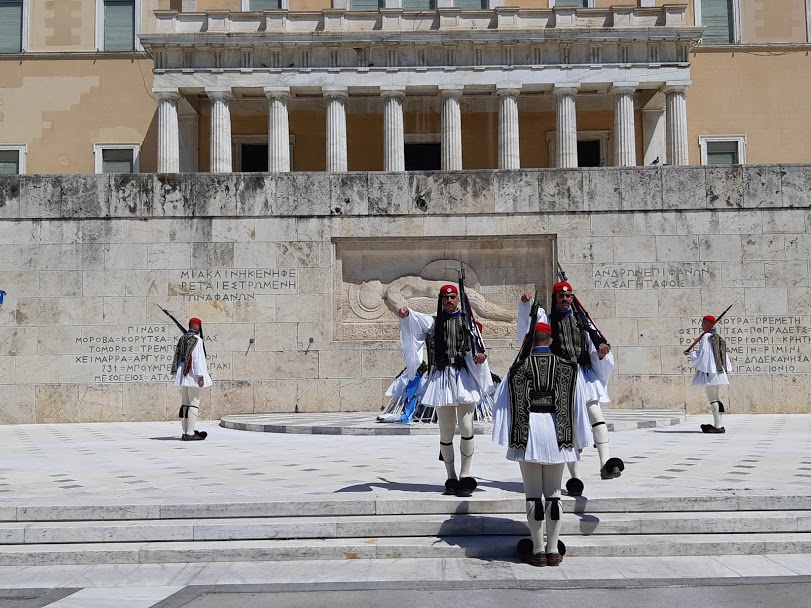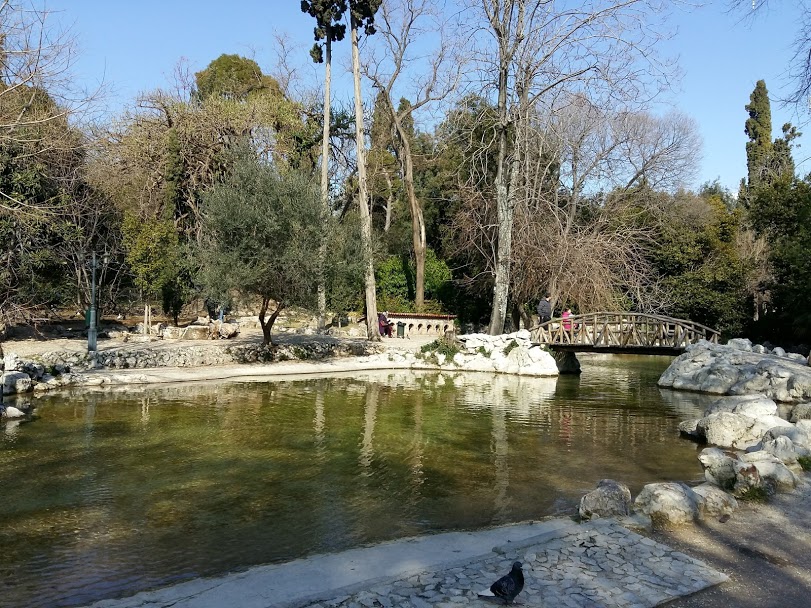The Athens National Garden is a beautiful green space right in the heart of the Greek capital. It’s a perfect spot to get away from the hustle and bustle of the city, and enjoy nature right in the heart of the city.

Athens National Gardens – Botanical Gardens in Athens
The National Garden in Athens, also known as the Athens Botanical Gardens, is a lovely green space right in central Athens. Whilst not nearly as big as other parks in Central and Northern Europe, it’s a popular place to for visitors and locals alike.

What is quite stunning about the National Gardens is the variety of trees and other plants. There are over 500 different species, of which about 400 are native to other countries.
It is estimated that the Gardens are home to over 7,000 trees and several thousand plants. Many of the trees were planted over 100 years ago.
Where are the National Gardens in Athens
The Athens National Gardens are located right next to the Parliament. This is where the popular Changing of the Guards happens every hour, on the hour. Couldn’t be any more central!
Most people access the Gardens from the central entrance at Amalias Avenue. This is across the street from Syntagma Square, only a couple of minutes away from the Parliament, and just outside Syntagma metro station.

Another entrance that you might want to use to get to the Gardens is close to the adjacent Zappeion park, towards the Panathenaic Stadium.
There are a few more entrances to the Gardens, but some of them are occasionally closed.
The History of the Athens National Gardens
The Botanical Gardens weren’t always there. To find out a little more about them, we have to go back at the times after the Greek Revolution in 1821.
In 1832, King Otto from Germany was appointed as the king of the newly established Greek State. He moved to Athens with his wife Amalia, and they commissioned the architect Friedrich von Gärtner to design his Palace, which is today’s Parliament building.

According to legend, Queen Amalia was missing the lush, green parks of her country, and she wanted to build a nice green space right next to the Palace. This is why the Gardens were called Royal Gardens, and they are also known as Gardens of Amalia.
The Gardens were designed by the German agronomist Friedrich Schmidt, with close supervision by Amalia. It is said that the Queen spent three hours in the Gardens on a daily basis, to make sure that they would be up to her standards.
Over 500 types of trees and plants were imported to decorate the Gardens, though not all of them survived our hot and dry climate. Amalia herself planted the twelve imposing Washingtonia trees that can be seen as you enter the Gardens.

The Gardens were finished in 1840, and they served as a public space during certain times of the day. The royal couple, on the other hand, had a part of the Gardens for their private use.
What to do in the National Gardens
If you want to get away from the hustle and the bustle of our noisy city, or just find a cool place to have a rest or a picnic, the Gardens are ideal.
While they are popular with visitors, you will also see several Athenians sitting on the benches, strolling around or maybe jogging. Sometimes, you may see people doing yoga or tai chi.

Walking around the Gardens you will come across a few ponds and lakes, where you will see some ducks and turtles. The duck numbers seem to vary by season.
Note: As a kid, I used to bring some bread with me for the ducks to eat, but apparently it’s not a good choice for them!
Inside the Gardens, there is a small area where a few animals and birds are kept. This mini-zoo used to be home to many more animals, including a lion. We find the cages pretty grim, but if you have children with you they will probably enjoy it.
Roman history and secret passageways
An interesting feature of the Gardens is an excavated Roman floor. There are also a few other ruins spread around. Also, underground tunnels pass underneath the Gardens, some of which used to be a part of irrigation systems.

According to legend, there may be other underground tunnels, which could be used for evacuation of the Palace in case of an emergency. No one knows If these actually exist, as it would have to be a top secret. Remember, the old Palace is today’s Parliament!
Near the Gardens’ main entrance, you will find a sun dial, a traditional method of telling the time. Check it out – maybe it’s not as easy as it looks!
The Zappeion Hall
Adjacent to the National Gardens there is a smaller green park, where you can see an imposing neoclassical building.
This building, known as Zappeion Hall, was designed by the famous Danish architect, Theophil von Hansen, who has designed numerous other buildings in Athens.

The Zappeion was donated to the state by a great benefactor, Evangelos Zappas. It was used as the Olympic village for the first modern Olympic Games, that took place in Athens in 1896. Today, it is often used for exhibitions and other events.
Inside the impressive courtyard you will see a collection of statues. Take some time to admire Lord Byron’s statue, raised in memory of the Philhellene English poet.

In summer, the Zappeion open air cinema offers movie screenings in the evenings. If you have never been to an open air cinema before, this is a great one! Or you can spend some time at the Aigli cafe.
Athens National Gardens
Have you been to the Athens National Gardens? What did you think to them? Let me know in the comments!

You might also be interested in:
- 15 Free things to do in Athens, Greece
- Free Museums in Athens
- Best things to do on a Sunday in Athens
- A local’s guide to taking the Athens metro
- Tips for staying cool in the summer in Athens

Hi! I’m Vanessa, a travel writer from Athens in Greece. I used to go to the National Gardens as a kid, so they have a very special place in my heart! If you have any questions about Greece, please get in touch through the Real Greek Experiences FB page and FB group.

I went to these gardens two years ago, 2022. I did not get bored, being a lover of gardening. Some of the plants are not native to Greece, so consider this if about to copy the species. Nice to see some huge and fully grown specimens.
Hi! Really appreciate your articles. Please consider changing this though: “ If that’s your cup of tea, you can bring some bread with you and feed the ducks.” I’ve heard bread is pretty bad for ducks and other water birds, so probably not something to encourage people to do. Better encourage people to support efforts that protect habitats that provide real food for birds and other wild species. Thanks!
Thanks – I’ve edited that!